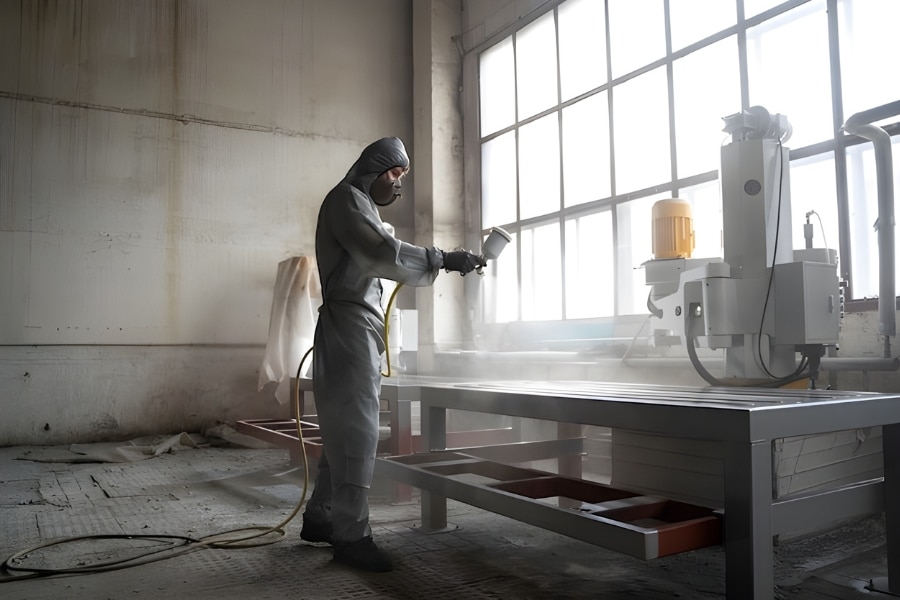Unlocking the Power of Corrosion Control Technology: Solutions for Industrial Durability
Introduction

Corrosion poses an ongoing challenge for industries worldwide, impacting structures and materials. This article delves into the realm of Corrosion Control Technology, offering insights into various methods, emerging technologies, and best practices to ensure robust protection against corrosion in industrial settings.
Corrosion Control Technology is crucial for industries seeking to fortify their defenses against the relentless threat of corrosion. This exploration encompasses an array of strategies, from traditional protective coatings to cutting-edge innovations like smart coatings and nanotechnology, providing a roadmap for industries to navigate the complex landscape of corrosion prevention.
Types of Corrosion

Understanding diverse forms of corrosion is crucial for effective defense. From uniform corrosion to pitting and crevice corrosion, each type poses unique threats to materials and structures. Recognizing these different manifestations allows for targeted and efficient corrosion control measures.
Corrosion, if left unchecked, can lead to structural failures and financial losses. Recognizing the severity of this challenge, industries are increasingly turning to advanced Corrosion Control Technologies to fortify their defenses. This exploration encompasses an array of strategies, from traditional protective coatings to cutting-edge innovations like smart coatings and nanotechnology, providing a roadmap for industries to navigate the complex landscape of corrosion prevention.
Common Corrosion Control Methods

Protective Coatings
At the forefront of corrosion control methods, protective coatings emerge as a stalwart shield, thwarting corrosive substances from infiltrating core materials. This section embarks on a comprehensive exploration of coating technologies, including epoxies, polyurethanes, and zinc-rich coatings. The article also discusses proper application techniques to ensure the longevity and effectiveness of protective coatings.
Epoxies, renowned for their adhesion and chemical resistance, form a resilient barrier against corrosion. Polyurethanes, with their flexibility and weather resistance, excel in outdoor applications. Zinc-rich coatings, acting sacrificially, provide an additional layer of defense by corroding in place of the underlying metal. Understanding the strengths and limitations of each type empowers industries to make informed choices in tailoring corrosion protection to their specific needs.
Cathodic Protection
Cathodic protection, a sophisticated strategy in corrosion defense, involves manipulating the metal to act as a cathode, inhibiting the corrosion process. This article demystifies the principles underpinning cathodic protection, delving into the intricate mechanisms of impressed current and sacrificial anode systems. Moreover, it places a spotlight on the critical aspects of installation and ongoing maintenance, offering valuable insights to guide industries in the seamless implementation of this highly effective corrosion control method.
Impressed current systems leverage an external power source to drive the cathodic protection process actively. Sacrificial anode systems, on the other hand, involve sacrificial materials that corrode in place of the protected metal. Both approaches demand careful consideration during installation, and regular maintenance is imperative to ensure sustained effectiveness. By understanding the intricacies of cathodic protection, industries can harness this advanced technology to fortify their assets against the corrosive forces at play.
Corrosion Inhibitors
Operating at a molecular level, corrosion inhibitors disrupt the corrosive process, offering a strategic defense against deterioration. This section navigates through the mechanisms of corrosion inhibitors, unveiling the diverse types available and providing considerations for their optimal application. Real-world examples take center stage, showcasing successful implementations of corrosion inhibitors across various industrial scenarios, illustrating their efficacy in real-world conditions.
Corrosion inhibitors operate through various mechanisms, such as forming protective films or altering the electrochemical environment. This section elucidates the intricacies of these mechanisms, aiding industries in selecting the most suitable inhibitor for their specific corrosion challenges. Real-world success stories underscore the versatility and reliability of corrosion inhibitors, offering inspiration for industries seeking effective and proven corrosion control solutions.
Emerging Technologies

As the technological landscape advances, corrosion control technologies evolve in tandem. This section is a deep dive into the transformative role of nanotechnology in corrosion prevention and the integration of smart coatings and sensors. Beyond merely discussing these innovations, the article underscores how they not only enhance the effectiveness of corrosion control measures but also usher in a new era of real-time monitoring for proactive maintenance, revolutionizing the approach to industrial asset preservation.
Nanotechnology, with its ability to manipulate materials at the molecular level, opens new frontiers in corrosion resistance. Smart coatings equipped with sensors provide real-time data on the structural health of materials, enabling timely interventions. This section not only provides insights into these trends but also underscores their potential impact on reshaping the landscape of corrosion control technology in the coming years.
Case Studies

Learning from practical examples is an invaluable aspect of refining corrosion control strategies. This section is a curated collection of case studies that illuminate successful corrosion control implementations in various industries. Each case study not only outlines the challenges faced but delves into the strategies employed, providing readers with actionable insights into achieving long-term corrosion resistance in diverse operational environments.
A case study from the maritime industry, for instance, may spotlight the challenges of saltwater corrosion and the successful implementation of cathodic protection. Another case study from the oil and gas sector could showcase how corrosion inhibitors were deployed to protect vital infrastructure. By delving into these real-world scenarios, industries gain a deeper understanding of the practical application of corrosion control methods and the adaptability required for different contexts.
Best Practices

The journey towards effective corrosion control extends beyond the mere implementation of technologies; it encompasses proactive maintenance strategies. This section delves into the core principles that constitute the foundation for sustaining corrosion control efforts in the long run, emphasizing the significance of a corrosion control course. From the necessity of routine inspections to the imperative adherence to industry standards and regulations, this segment presents a comprehensive approach to corrosion prevention. Diligently following these best practices significantly prolongs the lifespan of industrial assets.
Frontlining as the initial defense, regular inspections facilitate early detection of corrosion indicators, enabling timely interventions. Adherence to industry standards ensures the precise and effective implementation of corrosion control measures. Furthermore, compliance with regulations not only protects against legal consequences but also aligns with best practices, establishing a holistic and robust framework for corrosion prevention.
Future Trends

Corrosion control Technology is dynamic, constantly propelled forward by ongoing research and development. This section takes a forward-looking stance, exploring current trends and future predictions. From the integration of advanced materials to the application of machine learning for predictive maintenance and the embrace of sustainable corrosion control practices, this segment offers a glimpse into the trajectory of corrosion control technologies. Staying informed about these trends becomes a strategic imperative, preparing industries to navigate the challenges of tomorrow proactively.
Advanced materials, engineered for enhanced corrosion resistance, are becoming increasingly prevalent in the industry. Machine learning algorithms, when applied to corrosion data, enable predictive maintenance, minimizing downtime and maximizing asset lifespan. Sustainable corrosion control practices, such as eco-friendly coatings and materials, align with broader environmental goals. This section not only provides insights into these trends but also underscores their potential impact on reshaping the landscape of corrosion control technology in the coming years.
Conclusion

In summary, CORCON – The Institute of Corrosion underscores the mastery of Corrosion Control Technology as a paramount imperative for industries dedicated to preserving their assets and ensuring long-term durability. We advocate for the comprehensive adoption of an approach that embraces a diverse array of methods, seamlessly integrates emerging technologies, and steadfastly adheres to industry best practices. Through this holistic strategy, industries affiliated with CORCON can adeptly confront the multifaceted challenges presented by corrosion, ultimately prolonging the life expectancy of their investments.
The efficacy of Corrosion Control Technology, as championed by CORCON, is not a static achievement but an ongoing journey of exploration and improvement. Looking ahead, industries must remain vigilant in staying abreast of technological advancements, a crucial aspect in maintaining a resilient defense against the continuously evolving threat of corrosion. This concluding perspective from CORCON places significant emphasis on the perpetual significance of continuous learning, adaptation, and the seamless integration of cutting-edge solutions. By doing so, industries within the CORCON network fortify themselves against the relentless forces of corrosion, ensuring a future that is both resilient and enduring for their valuable assets.
FAQs
Q1: What is Corrosion Control Technology?
A1: Corrosion Control Technology involves various methods and technologies aimed at preventing and mitigating corrosion, a persistent challenge faced by industries globally. It encompasses protective coatings, cathodic protection, corrosion inhibitors, and emerging technologies like nanotechnology and smart coatings.
Q2: Why is understanding the types of corrosion crucial? A2: Understanding different forms of corrosion, such as uniform, pitting, and crevice corrosion, is crucial for effective mitigation. Each type poses unique threats to materials and structures, requiring targeted and efficient corrosion control measures.
Q3: How do protective coatings contribute to corrosion control technology?
A3: Protective coatings act as a shield, preventing corrosive substances from reaching underlying materials. This includes exploring coating technologies like epoxies, polyurethanes, and zinc-rich coatings, with a focus on proper application techniques.
Q4: What is the role of emerging technologies in corrosion control?
A4: Emerging technologies like nanotechnology and smart coatings enhance the effectiveness of corrosion control Technology. They provide real-time monitoring for proactive maintenance, revolutionizing the approach to industrial asset preservation.
Q5: Why are case studies important in corrosion control discussions?
A5: Case studies highlight successful corrosion control implementations in various industries, offering practical insights into challenges faced and strategies employed. They provide real-world examples that can guide industries in achieving long-term corrosion resistance
Image Reference : Freepik
Disclaimer: All trademarks, logos, and brand names are the property of their respective owners. All company, product, and service names used in this website are for identification purposes only. Use of these names, trademarks, and brands does not imply endorsement.


